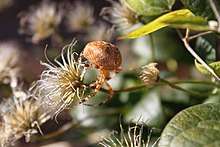Araneus diadematus
| Araneus diadematus | |
|---|---|
| Female, size=18 mm[1] | |
.jpg) | |
| Male | |
| Scientific classification | |
| Kingdom: | Animalia |
| Phylum: | Arthropoda |
| Subphylum: | Chelicerata |
| Class: | Arachnida |
| Order: | Araneae |
| Infraorder: | Araneomorphae |
| Family: | Araneidae |
| Genus: | Araneus |
| Species: | A. diadematus |
| Binomial name | |
| Araneus diadematus | |
The spider species Araneus diadematus is commonly called the European garden spider, diadem spider, orangie, cross spider and crowned orb weaver. It is sometimes called the pumpkin spider,[3] although this name is also used for a different species, Araneus marmoreus.[4] It is an orb-weaver spider found in Europe and North America.
Range

A. diadematus has a holarctic distribution, found throughout Europe and across North America, from southern Canada to Mexico, and from British Columbia to Newfoundland.[5][6]
Size and markings
Individual spiders' colourings can range from extremely light yellow to very dark grey, but all A. diadematus have mottled white markings across the dorsal abdomen, with four or more segments forming a cross. The markings are formed in cells filled with guanine, which is a byproduct of protein metabolism.[7]
Adult females range in length from 6.5 to 20 mm (0.26 to 0.79 in), while males range from 5.5 to 13 mm (0.22 to 0.51 in).[8] Occasionally, the female will eat the male directly after mating. (See video below.)
Specialization
The legs of orb-weaver spiders are specialized for spinning orb webs. The webs are built by the larger females who hang head down in the center of the web or remain hidden in nearby foliage, with one claw hooked to a signal line connected to the main orb waiting for a disturbance to signal the arrival of prey. Prey is then quickly bitten and wrapped in silk before being stored for later consumption. The initial bite serves to paralyze the prey and minimize the danger of the spider herself being stung or bitten, and the enzymes thus injected serve to begin liquefaction of the prey's internal structures.
A. diadematus is a reclusive creature and only bites humans if cornered or otherwise provoked.
Some orb-web spiders (e.g., Neoscona arabesca) routinely recycle the metabolically costly silk by disassembling and eating their webs in the morning or evening, depending on the species' diurnal or nocturnal nature, or in anticipation of a thunderstorm. This complex process can take just a few minutes.[9]
Gallery
 Spiderlings in an orb web
Spiderlings in an orb web- Ventral view
References
| Wikispecies has information related to Araneus diadematus |
| Wikimedia Commons has media related to Araneus diadematus. |
- ↑ Cirrus Digital: Crowned Orb Weaver - Araneus diadematus
- ↑ Nikita J. Kluge (2007). "Case 3371. Araneidae Clerck, 1758, Araneus Clerck, 1758 and Tegenaria Latreille, 1804 (Arachnida, Araneae): proposed conservation" (PDF). Bulletin of Zoological Nomenclature. 64 (1): 15–18.
- ↑ Hawkes, Alison (31 October 2012), "Signs of the Season: Pumpkin spiders on the move", Bay Nature, retrieved 2017-11-12
- ↑ "Species Araneus marmoreus - Marbled Orbweaver", BugGuide, retrieved 2017-11-12
- ↑ Cross Orbweaver; at BugGuide online; retrieved April 2013
- ↑ Cross Spider, Washington NatureMapping Project
- ↑ Rainer F. Foelix (1992). Biologie der Spinnen [Biology of the Spiders] (in German). Stuttgart: Thieme. ISBN 978-3-13-575802-2.
- ↑ Cross Orbweaver, Penn State Entomology
- ↑ Cirrus Digital:Orb Weaver Spider - Neoscona arabesca
External links
- European orb-weavers at Spiders of NW-Europe